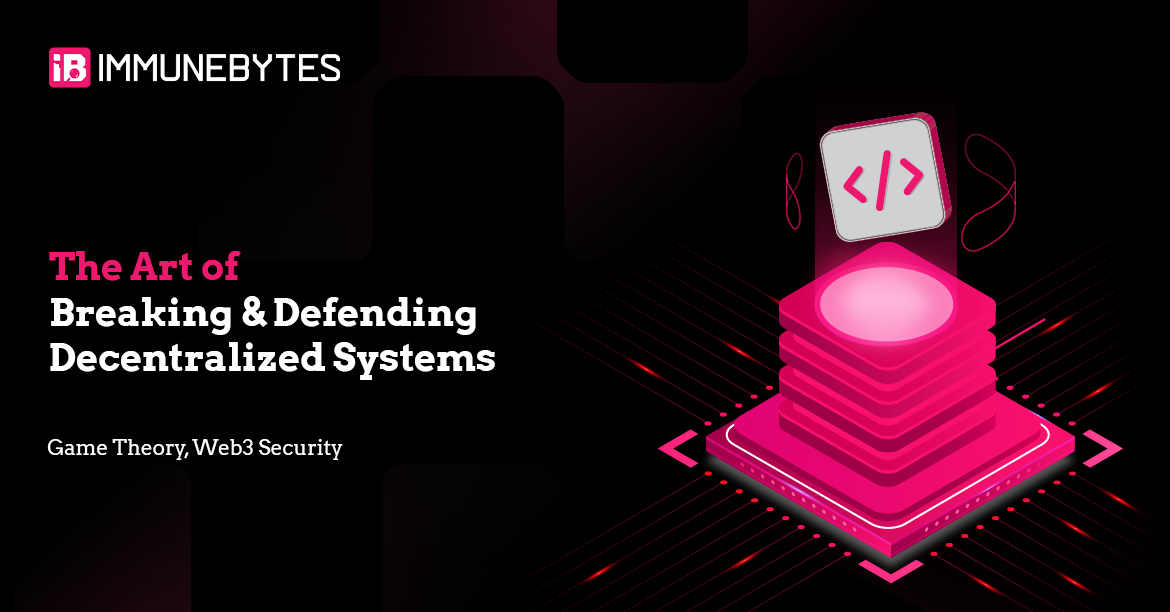I used to think of blockchain security as a war of code; finding vulnerabilities in business logic of DeFi or NFT smart contracts, making and breaking secure communication and encryption protocols in cryptography, or mathematically finding properties and specifications that do not hold using formal verification. But the deeper I got into it, the more I realized that blockchain security isn’t about code alone. It’s about games, strategic, adversarial, ever-evolving games. And in these games, the attacker always moves first.
Imagine for instance: If you were an attacker, how would you break a blockchain system? Just exploit a bug? Or outmaneuver the entire security model?
What if I told you that an attack isn’t just a singular exploit, but a multi-step, multi-round engagement where the attacker plays a perfect strategy against an imperfectly defended system? That’s what adversarial game theory is about. And that’s why blockchain security is, at its core, a contest of who plays the better game.
Breaking the System: How Attackers Play Their Moves
Adversarial game theory, in its simplest form, describes how two rational agents—an attacker and a defender—compete with opposing incentives. But here’s where it gets interesting: Most attacks on blockchain protocols aren’t single-shot exploits. Instead, they unfold like multi-round strategic games, where attackers take advantage of predictable defender behaviors, incentive mismatches, and information asymmetry. Let’s see this in action.
Step 1: The Recon Phase (Attacker’s Information Advantage)
Every good adversarial game starts with information asymmetry—one side knows more than the other. The attacker always has the first-mover advantage because they choose when, where, and how to attack.
- MEV Bots vs. Unprotected Transactions → When a user submits a large trade to a decentralized exchange (DEX), they think they’re safe. But an attacker (in this case, an MEV bot) sees the transaction in the mempool before it gets executed and frontruns it, extracting value.
- Cross-Chain Bridge Exploits → Attackers monitor bridge transactions, searching for minor inconsistencies in state synchronization. Once they find one, they don’t attack immediately. Instead, they test the system with small, incremental transactions—observing how validators respond.
| Key Point to Remember: Every attack starts with a deep understanding of the defender’s blind spots. The more predictable a protocol’s behavior, the easier it is to game. |
|---|
Step 2: Signaling & Deception (The Game Before the Game)
This is where game theory really shines—attackers don’t just act; they signal, bluff, and mislead.
Imagine a Stackelberg Game, a fundamental model in adversarial game theory where one player (the attacker) moves first, and the second player (the defender) reacts.
- The Nomad Bridge Exploit (2022) → One of the most fascinating adversarial plays I’ve ever seen. The attacker didn’t just drain the bridge immediately—instead, they subtly signaled a vulnerability by making a strange-looking transaction that mirrored a legitimate one.
- Other attackers saw the signal and piled in, leading to a frenzied open attack where over $190M was drained—not by one attacker, but by hundreds.
The first attacker manipulated the network’s perception, triggering a catastrophic event by exploiting the way people react to visible vulnerabilities.
| Key Point to Remember: In adversarial games, sometimes the best move isn’t attacking directly—it’s letting others do it for you. |
|---|
Step 3: The Multi-Round Attack (Why Simple Defenses Fail)
In most cases, defenses are designed for single-round attacks—a smart contract bug gets exploited, a patch gets deployed, and the problem is “solved.”
But what happens when an attack unfolds over multiple rounds?
- Governance Attack Playbooks → Attackers start with a small governance proposal that looks innocent.
- Once it passes, they submit a follow-up proposal that slightly changes incentive mechanisms.
- Only after multiple iterations do they introduce a malicious change, slowly draining treasury funds.
This multi-step adversarial strategy is why I argue that blockchain security isn’t about patching code—it’s about patching game mechanics.
| Key Point to Remember: If your protocol can be exploited in phases, assume attackers will take their time. Fast hacks are flashy. Slow hacks are lethal. |
|---|
The Dark Forest & The Silent Killers
This is where we talk about the game that’s played in the shadows.
If you’ve been around blockchain security long enough, you’ve probably heard of the Dark Forest Theory. Dan Robinson and Georgios Konstantopoulos wrote about it in 2020 when they attempted a white-hat rescue of a vulnerable Ethereum contract.
Here’s what happened:
- They saw a wallet with exposed private keys.
- They tried to recover the funds by sending a transaction to move the assets before an attacker did.
- Before their transaction was confirmed, an MEV bot frontran them and stole everything.
The lesson? If your transaction is visible, it’s already too late. The mempool is a battlefield where every move is anticipated and countered.
| Key Point to Remember: Every transaction broadcasted to the mempool is an open invitation for attackers to optimize against you. |
|---|
Final Moves: Why This Game Never Ends
Blockchain security isn’t about preventing all attacks—that’s impossible. It’s about understanding the game attackers are playing and designing defenses that break their strategies before they break your protocol.
This is where we fail the most:
❌ We assume attackers think like us.
❌ We assume security is a technical problem, not an incentive problem.
❌ We assume that one-time patches fix problems permanently.
But attackers never stop playing. They analyze your incentives, predict your countermeasures, and adjust their strategy.
| Key Point to Remember: Every defense creates a new game. Every game has new rules. And the ones who understand these rules best—win. |
|---|
What You Should Worry About More Than You Do
I’ll leave you with a few things that should keep you up at night:
🚨 Single-shot defenses don’t work – If your security model assumes attackers will try once and leave, you’ve already lost.
🚨 Everything in blockchain is a game of asymmetric information – Attackers always see more than defenders.
🚨 If an attack looks too simple, you missed the deeper play – Most exploits that look basic on the surface are actually multi-step attacks disguised as low-effort hacks.
🚨 If incentives aren’t aligned, someone will eventually exploit them – Doesn’t matter how much you audit the code—if there’s money to be made, someone will play the game.
Closing Thought: This Is Why I Love This Field
Blockchain security isn’t just about code. It’s about predicting human behavior under adversarial conditions. It’s about thinking like an attacker while designing like a defender. And most importantly—it’s about always staying one move ahead.
🚀 Your Move. What’s the next adversarial strategy you think we’ll see in the wild?

